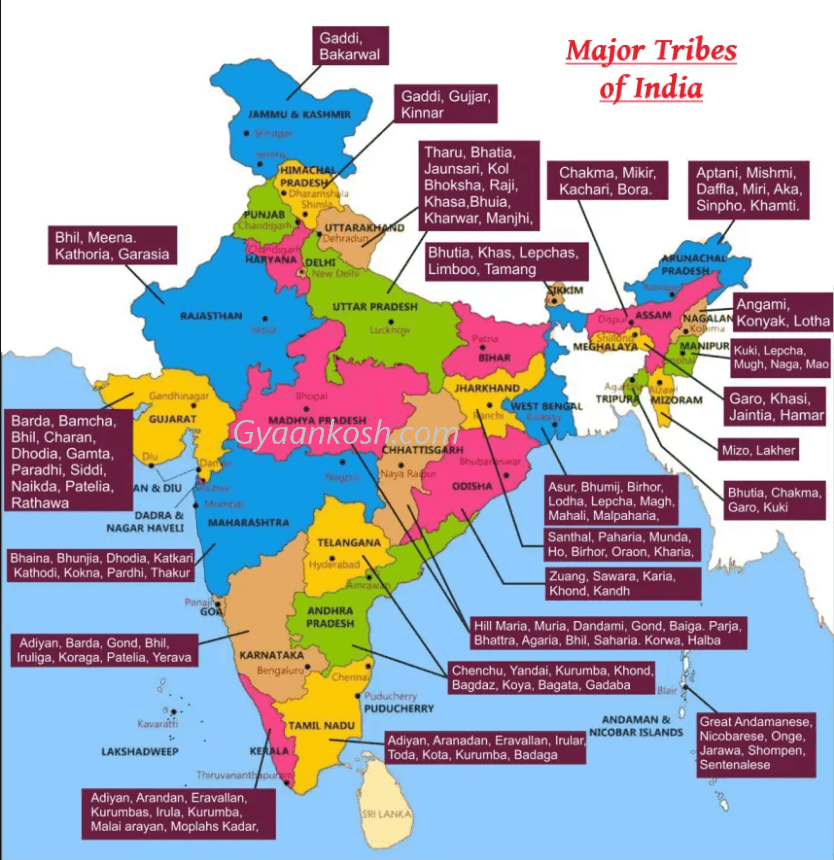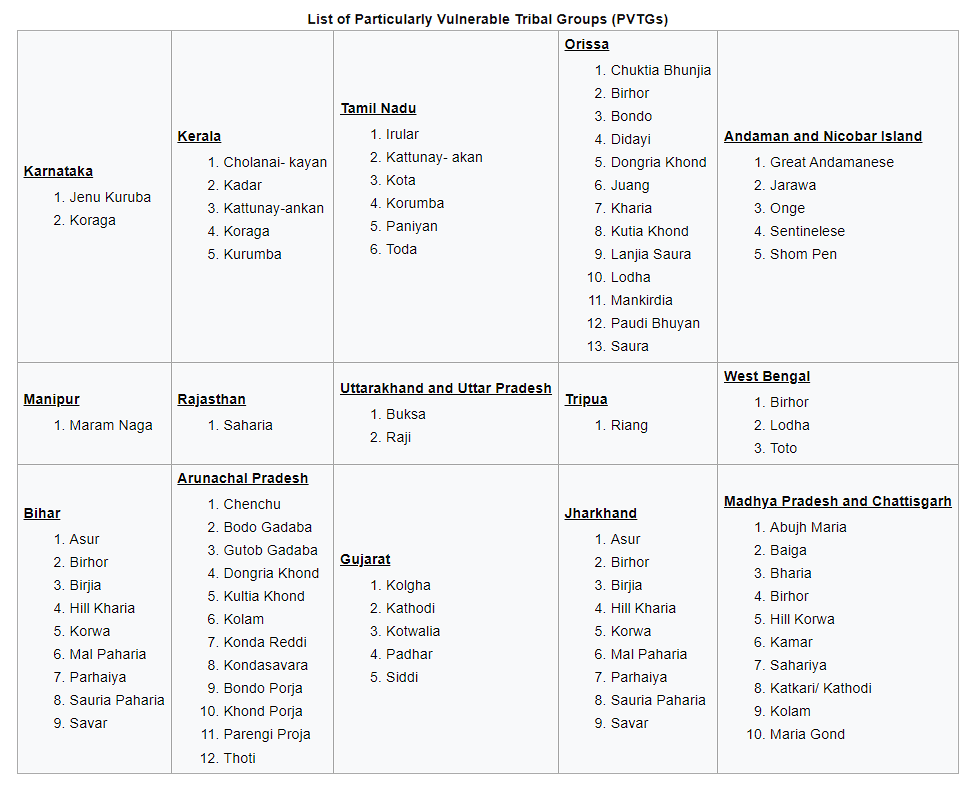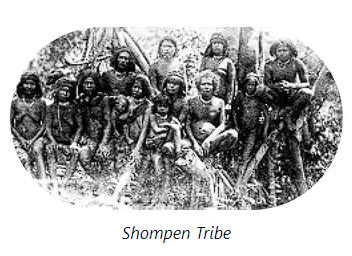Major Tribes of India
Read about the Major Tribes of India found in every state of India with their religion, customs, arts, beliefs etc.

Particularly Vulnerable Tribal Groups (PVTG)
- Earlier known as a Primitive tribal group.
- Sub-classification of Scheduled Tribe.
- Vulnerable Group.
- Resides in 18 States and 1 UT.
- Total of 75 groups were identified as PVTG.
- Dhebar Commission (1960-1961) found that within the Scheduled Tribe classification an inequality existed in the rate of development of certain tribes over others.
- As a result in the fourth Five Year Plan the sub-category “Primitive tribal group” was created within the grouping of Scheduled Tribe to identify groups considered to be especially lacking in modern development.
- PVTG list was created by the Indian Government with the purpose of better improving the living standards of endangered tribal groups based on priority.
- Features of this tribe
- Pre-agricultural system of existence,
- Practice of hunting and gathering,
- Zero or negative population growth,
- Extremely low levels of literacy in comparison with other tribal groups.

Shompen Tribe

- Shompen TribeAbout Tribe
- Indigenous people of the interior of Great Nicobar Island.
- Designated as a Particularly Vulnerable Tribal Group (PVTG).
- They practice a hunter-gatherer subsistence economy.
- The traditional attire for men is a short, thin loincloth made of bark cloth, covering only the genitals without a ‘tail’ of cloth in front.
- Women wear a knee-length skirt of bark cloth, occasionally with a shawl of bark cloth covering the shoulders.
- Decorations include bamboo ear plugs (ahav), bead necklaces (naigaak) and armbands of bamboo (geegap).
- The main weapons are the bow and arrow.
- Numerous types of spears, spear throwers, fire drills and a hatchet are the main tools.
- A polling station was set up in their area for election of 2014. Shompen people for the first time participated in the democratic process.
- Threat to tribe
- Due to proposed Great Nicobar Development Plan, hectares of land on Great Nicobar Island will be reclaimed and may impact 1,700 people including many Shompens.
Warli Tribe
News – Warli tribe in Mumbai objects to construction of Shivaji museum.

- Indigenous tribe of western India.
- Have their own animistic beliefs, life, customs and tradition and thus, have adopted many Hindu beliefs.
- Warli speak the unwritten Varli language which belongs to the southern zone of the Indo-Aryan languages.
- Have sub castes such as Murde varli, Davar varali.
- Found in –
- Jawhar, Vikramgad, Mokhada, Dahanu and Talasari talukas of the northern Palghar district and parts of Nashik and Dhule as well as Navapur taluka of Nandurbar of Maharashtra,
- Valsad, Dangs, Navsari and Surat districts of Gujarat,
- UT of Dadra and Nagar Haveli and Daman and Diu.
- Warli painting is the cultural intellectual property of the tribal community.
- They were traditionally semi-nomadic. They lived together in small-scale groups with a headman leading them.
- However, recent demographic changes have transformed the Warli today into mainly agriculturists. They cultivate many crops like rice and wheat.
- Warli women wear toe-rings and necklaces as a sign of being married.
- Some Warli practice polygyny.
Gond Tribe

- Group of aboriginal peoples.
- Designated as Scheduled Tribes.
- Refer to themselves as “Kōītōr” (Kōī, Kōītōr).
- Found in the states of
- Madhya Pradesh,
- Maharashtra,
- Chattisgarh,
- Telangana,
- Andhra Pradesh,
- Bihar,
- Odisha.
- Speaks Gondi, an unwritten language of the Dravidian family.
- Gondi is claimed to be related to the Telugu language.
- Some Gond have lost their own language and speak Hindi, Marathi, or Telugu, depending on which is dominant in their area.
- No cultural uniformity.
- Religion of all Gond peoples centres in the cult of clan and village deities, together with ancestor worship.
- Many Gond people practice their own indigenous religion, Koyapunem (), while some follow Sarnaism.
- The Gonds worship ancestral deities known as Angadevs, which Brahminical Hindus claim are a representation of the goddess Mahakali.
- A typical Gond reaction to death has been described as one of anger, because they believe death is caused by demons.
- Gonds usually bury their dead, together with their worldly possessions, but due to partial Hinduization, their kings were occasionally cremated, as per Vedic practices.
- Hinduization has led to cremation becoming more common.
- The most developed are the Raj Gond, who once had an elaborate feudal order. Local rajas, linked by ties of blood or marriage to a royal house, exercised authority over groups of villages.
- The Raj Gond continue to exist outside the Hindu caste system, neither acknowledging the superiority of Brahmans nor feeling bound by Hindu rules such as the ban on killing cows.
- The highlands of the Bastar region in southern Chhattisgarh are the home of three important Gond tribes –
- Muria –
- Known for their youth dormitories, or ghotul, in the framework of which the unmarried of both sexes lead a highly organized social life.
- They receive training in civic duties and in sexual practices.
- Bisonhorn Maria –
- Bisonhorn Maria, so called for their dance headdresses, live in less-hilly country and have more-permanent fields that they cultivate with plows and bullocks.
- Hill Maria –
- The last, who inhabit the rugged Abujhmar Hills, are the most isolated.
- Their traditional type of agriculture is slash-and-burn (jhum) cultivation on hill slopes; hoes and digging sticks are still used more than plows.
- The villages are periodically moved, and the commonly owned land of each clan contains several village sites occupied in rotation over the years.
- Muria –
Bagata Tribe

Recently News :- The Bagata tribal people who laboured on the Lower Sileru Hydro-Electric Project construction, still live without electricity and remain in darkness.
- An aboriginal tribe of India.
- Primarily living in the states of Andhra Pradesh and Odisha.
- Also known as Bagatha, Bagat, Bagodi, Bogad, or Bhakta.
- Trace their community name to devoted warriors (Bhaktas) of the former rulers.
